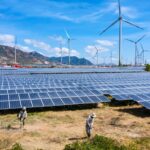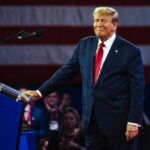The Federal Reserve Building in Washington, DC.
chip somodevilla/getty image
In the international community, the Federal Reserve is the most respected institution in the United States. In Asia, investors are often more concerned about what they do with the Fed in Washington than local central banks.
So it’s confusing why President Donald Trump burned an entity at the center of the U.S. Financial Impact Center. However, this is exactly what Trump is doing except fishing and firing the chair Jerome Powell.
The Trump team is also looking for ways to exert power over 12 regional Fed banks. Probably the scope of Trump’s appointment of his president. Currently, the private sector boards have a great say in who runs regional banks.
No one thinks the 112-year-old Fed system is ideal. Although the Fed’s dual task is to achieve full employment and price stability, mistakes will inevitably happen. For example, in 1994, the Fed began a radical 12-month tightening cycle, which caused shock waves everywhere.
By doubling the tax rate in just one year, the Fed brought Mexico into crisis under Chairman Alan Greenspan, helping bankrupt Orange County, California and closed Wall Street bond giants Peabody & Co, Peabody & Co.
However, if Trump does not understand the “high privilege” that Washington enjoys and why the United States wants to keep it – Scott Bessent may be able to go to school from him. As former hedge foundation Guy, the secretary of the Finance Minister must know what French Finance Minister Valéry Giscardd’Estaing meant when he created this sentence in the 1960s.
Since the United States is home to its largest economy and reserve currency, the government can live outside its means just like other countries. It can be borrowed at a lower tax rate than before. And, the dollar can be avoided anywhere, anywhere.
This state explains why Moody’s Investor Service took Washington’s last AAA rating in May and didn’t make any money. The U.S. Treasury Department will not soar. Indeed, excessive privilege.
The Fed is the glue that holds everything together. Economists can debate whether the Fed should save markets when tax rates are lowered strategically. Originally the “Greenspan Proposal” of the 1990s created a practice, and since then, raising leaders have been retained.
The risk is that Trump turns the Fed into a “give up” rather than sobering agency. William McChesney Martin, the 1950s chairman, famously said that the Fed’s job was to blow the fist away at the beginning of the party.
The risk of “Argentinaization” by Trump firing the head of the Bureau of Labor Statistics is already high, as data show jobs slow. Trump’s sterilization of the Fed’s independence could lay the foundation for a surge in inflation disaster.
The damage of this gambit will be difficult to reverse. Trump’s tariffs could be lifted. His efforts to pull the U.S. out of the renewable energy race and extract Detroit from the electric vehicle market could be reversed. His budget tax cuts could be abolished. However, restoring trust in the Fed will be more challenging.
Asia is directly at the frontline of this risk. It’s investment and export-driven like any region. Global markets will become more turbulent and more predictable as Trump’s attack on Fed autonomy undermines the dollar and increases the gains of the U.S. treasury.
“If the president succeeds, the outcome will be important,” said Michael Feroli, chief economist at JP Morgan, adding: “This will increase the risk of rising inflation.”
And adds to Asia’s concern that 2026 may be much worse than 2025.








